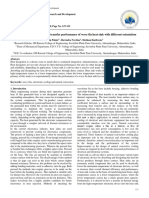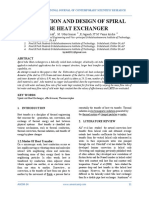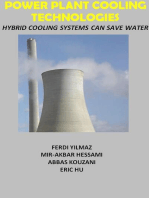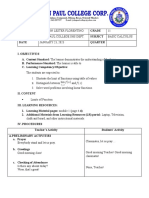Cooling of Electronic Equipmentteam8
Cooling of Electronic Equipmentteam8
Uploaded by
Amey PuranikCopyright:
Available Formats
Cooling of Electronic Equipmentteam8
Cooling of Electronic Equipmentteam8
Uploaded by
Amey PuranikCopyright
Available Formats
Share this document
Did you find this document useful?
Is this content inappropriate?
Copyright:
Available Formats
Cooling of Electronic Equipmentteam8
Cooling of Electronic Equipmentteam8
Uploaded by
Amey PuranikCopyright:
Available Formats
1
. MAE 585, Solar Thermal Engineering, spring 14
Department of Mechanical Engineering, Arizona State University
May 2, 2014, Tempe, AZ, USA
COOLING OF ELECTRONIC EQUIPMENT
Navya Gundeti, Anand Sethuramu, Rutuja Bhadre, Santosh Pattanad, Pushkar Naik
School for Engineering of Matter, Transport, and Energy
Arizona State University
Tempe, AZ, USA
ABSTRACT
The methods of cooling of electronic equipment were studied
and their mechanisms analyzed. Jet impingement technique was
selected for performing experiment and analyzing the cooling
patterns on the copper plate, which acts as a prototype for
heated electronic equipment. The experiment was conducted on
four cases, varying the H/D ratio and the distance of stagnation
point from the center. The data collected was tabulated and
graphs with the same data were plotted. Further a CFD
simulation was carried out to cross verify the experimental
result.
NOMENCLATURE
L=characteristic length
V=voltage in volts
P
m
=Mean power loss
T = waveform period
i(t)=instantaneous value of current through the
element
v(t)=instantaneous value of voltage through the
element
t
1
= lower limit of conduction for the current
t
2
= upper limit for the current
P = power in watts or joules/sec
I = current in Amps
T =temperature difference between the solid surface
and surrounding fluid area
H = distance between nozzle and surface
D = diameter of jet impinging nozzle
INTRODUCTION
Electronic systems cooling have been extensively
examined recently because of the interest from both scientific
and technological points of view. In the technological part, with
the improvements of the electronics systems, higher processing
speeds, more power, smaller systems become more of a
necessity than ever before. One of the most important results of
these necessities is the need to handle more complex
geometries. Therefore one of the biggest issues in the
electronics systems is the cooling of these complex geometries.
Especially in military, healthcare and aerospace applications,
effective cooling is crucial. With an efficient cooling,
electronics systems become more reliable and durable [1].
On the scientific part, heat that is generated in electronic
systems is proportional to the square of voltage and the
frequency of the system. So, engineers try to increase the
frequency and decrease the voltage to be able to decrease heat
generation. Developing effective cooling techniques of
electronic systems is a major challenge. Therefore different
cooling techniques have been developed to remove the heat
from electronic components.
Major Methods of Cooling
Major methods of cooling were considered and a market
research was done on them:
Conduction Cooling: It is a cooling system mainly used
for harsh-environment applications where conventional,
air-cooling techniques cannot be used. Its study
revealed that increasing number of military applications
require conduction cooling where systems were sealed.
It can be noted that Heat spreading is a very effective
way of mitigating the need for sophisticated high-heat
flux cooling options. Research shows that conduction
cooling is based on the diffusion of heat through a
solid, liquid, or gas as a result of molecular interactions
in the absence of any bulk fluid motion [2]. Conduction
cooling can be carried out using: Metal pads and Heat
pipe.
Thermal Conduction Module: Innovative heating
technique introduced, by IBM for 3081 Processor Unit
[2]. Unlike conventional methods, IBM has come up
with TCM concept. Analysis shows that in TCM, one
side of the chip is reserved for electrical connections
and the other side for heat rejection. It was observed
that the chip was cooled by direct contact to the cooling
system to minimize the junction-to-case thermal
resistance.
Piezoelectric Cooling: Market research on this revealed
that once an exchanging current passes through a
ceramic segment, it grows and contracts at up to 150
times each second so the nickel plates act like a howls
2
[4]. It was seen that at the point when the piezoelectric
material chokes, the edges of the two-nickel circles
were pushed together so they twist far from one another
and suck in hot air from the encompassing range. At
that point, when the piezoelectric material extends, the
nickel circles meet up and the air was casted out from
the core at high speed, which resulted in cooling.
Phase Change Material: It is a very safe method of
cooling which uses a Heat Storage Unit HSU,
consisting of a Phase change material. Studies show
that it is a technique used for limiting temperature
increases and/or minimizing the performance
requirements of a heat sink when electronics are
operated under transient conditions, increasing the
thermal capacitance [3]. It was noted that one effective
method of increasing thermal capacitance is to include
a material that undergoes a change of phase at a
desirable temperature.
Jet Impingement Technique: Jet impingement is an
attractive cooling mechanism due to the capability of
achieving high heat transfer rates. It was observed that
Jet impingement has become a viable candidate for
high-powered electronic and photonic thermal
management solutions and numerous jet impingement
studies have been aimed directly at electronics cooling.
THEORY
Every electronic component depends on the passage of
electric current to perform its obligation, and it becomes the
potential site of heat generation. Current permeating active and
passive components results in power dissipation and
incremented temperatures. The amount of puissance dissipated
by a contrivance is a function of geometry and the path from
the contrivance to the heat sink. Power dissipated will be a
function of the type of current that it receives for DC power
dissipated, = , and for AC is
=
1
()()
2
.
Jet impingement is a cooling system of having a capability
of having high heat transfer rates. The method of cooling is
used in a wide range of applications in industry such as
annealing of metals, cooling gas turbine blades, cooling in
process of grinding and cooling of photovoltaic cells. Jet
impingement has become a very important aspect of high-end
electronic and photonic thermal management solutions;
numerous jet impingements have been studied directly aimed at
electronics cooling.
With increase of power in electronic devices, processors,
etc. that are requiring high capacity cooling methods to remove
extra heat. A method of doing this is jet impingement of a gas
or liquid in surface continuously. The mode of heat transfer has
been studied and tested extensively for a lot of time and
research is still going on. High speed jet impingement on a
component surface creates a thin boundary layer, and thus a
high heat transfer equation. With three common jet
configurations: the free-surface jet, which uses dense liquid in a
medium that is less dense; Submerged jet, allows fluid to
impinge in the same medium fluid; and confined submerged jet,
which is shown in Figure 1.
Studies have been carried out that the spacing of jet-to-
target has a large influence for heat transfer in a submerged jet
than that for free-surface jets. Studies suggest very small
change in stagnation and average heat transfer for ratio of H/D<
4, then a decrease of heat transfer occurs as H/d increases
beyond this point.
EXPERIMENT
The experiment is conducted to observe the cooling
patterns of the copper plate, which is used as a prototype for
electronic equipment. The components used in the experiment
can be described as follows:
Components:
Fig 1. Experimental Setup Schematic
1. Test Plate: A copper plate of 0.01m diameter and
thickness 5mm. The copper plate consists of holes
drilled half way through to facilitate the placing of
thermocouples. The surface is given appropriate
finishing to give the best results.
2. Heater: A heating coil heater is used to heat the copper
plate to the desired temperature. The capacity of the
heater is about 1000W.
3. Thermocouples: Thermocouples are used at various
points on the copper plate to measure the temperature
at different points starting from the center of the plate.
The thermocouples used are copper constantan, which
3
were arranged at the required positions on the plate for
the temperature readings.
4. Nozzle: The nozzle is the pipe through which the high
velocity jet comes out. There are various types of
nozzles, the plain type, swirling strip nozzle and the
twisted nozzle. For this experiment we have used a
plain nozzle for all the cases considered. The nozzle
used had an internal diameter of 7mm and a thickness
of 1mm. The length of the nozzle was developed such
that by the time the jet reaches the end of the nozzle, it
reaches fully developed flow. This was achieved by
calculating the length to diameter ratio.
5. Pump: A pump was used to produce high velocity air.
This pump is adjusted that it gives a constant mass
flow rate of 2.77x10
-4
Kg/s. The temperature gained by
the air in this process of increasing the velocity is
neglected, as this temperature is extremely negligible
compared to the temperatures attained by the pump at
the time of heating.
6. Rotameter: A rotameter is used to make sure the mass
flow rate is constant at different times by regular
inspection and accordingly change the pump outlet if
there is a deviation.
7. Stand: A very normal and fundamental stand was used
to hold the pipe coming from the compressor to the
nozzle in place and to change the heights and the
stagnation point distances from the center. A basic
table was used to place the heater and plate at
appropriate height.
The experiment setup is illustrated in the Figure 1.
Parameters
There are many parameters that have been considered for
observation in the history of jet impingement. The various
parameters that can be considered are listed below:
H/D Ratio: The H/D Ratio is the ratio of height of the
nozzle exit from the plate to the diameter of the nozzle.
This is a very important parameter considered in the jet
impingement technique.
Nozzle type: The type of nozzle used is another variable.
There are many types of nozzles like plane nozzle,
nozzles with swirling strip and twisted nozzle.
Angle of inclination: The angle at which the nozzle is
impinged on to the jet.
Stagnation point off set: The point where there is
maximum heat transfer is called the stagnation point.
This is usually the geometrical center when its a circular
tube.
However the cases considered in this experiment are listed as
follows:
1. H/D = 5, R = 0
2. H/D = 5, R = 1.5
3. H/D = 3, R = 0
4. H/D = 3, R = 1.5.
Procedure
The experiment was conducted to using the components
mentioned above to observe the cooling pattern of the copper
plate. Ambient air is sucked into the pump to pressure high
velocity jet. The flow rate of the jet is maneuvered using the
outlet valve of the pump to make sure the mas flow rate of the
jet coming out of the nozzle is maintained at 2.77x10
-4
kg/s. The
high velocity airflows through the pipe enter the nozzle and
come out of the nozzle tip. Because of the appropriate length
selected, the flow will be fully developed by the time it reaches
the tip. The copper plate is heated to 175
0
C and after it attains
that temperature, the power or the heating is shut down. The jet
from the nozzle is then impinged on to the heated copper plate
and the after every fixed time interval, the temperature of
various points on the plate are noted. The step-by-step
procedure can be listed as follows:
i. Initially the pump is switched on so that the pressure is
built up and then it is run till the desired mass flow
rate is obtained.
ii. The heater is switched on and the plate is heated till it
attains a temperature of 175
o
C.
iii. Once uniform temperature of 175
o
C is attained on the
test plate, we turn of the heater and impinge the jet on
the test plate.
iv. Readings are taken at different points on the test plate
at regular time intervals using thermocouples.
v. This procedure is repeated for the following cases
a. Case 2 H/D=5, R=1.5
b. Case 3 H/D=3, R=0
c. Case 4 H/D=3, R=1.5
vi. Graphs are plotted to show the variation of
temperature with respect to time for various positions.
RESULTS AND DISCUSSION
1. H/D=3, R=0.
It is observed from the Figure 2, that after the heater
was switched off, the plate when impinged with jet
begins to rapidly lose temperature at the stagnation
point, which is at the center of the plate. Ten minutes
later, the center obtains a temperature of 70 while the
outer edge, i.e. the farthest point from the center has a
temperature of 90 while the stagnation point cools off
rapidly to a temperature of 70. The total time taken
for the copper plate to attain a temperature of 45
using a plain nozzle with h/d=3 is 40mins.
2. H/D=5, R=0
Figure 3 shows the cooling patters of various points on
the heated plate. Considering the stagnation point, it
lost temperature rapidly from 175 to 85 in the first
ten minutes and then cools in a constant curve from
85 to 48 by the end of 40 minutes. From here it takes
a slow pace to reach a temperature of 45 by the end
of 60mins.
4
Fig 2 Cooling rate for H/D =3 and R=0
Fig 2 Cooling rate for H/D =3 and R=0
Fig 3 Cooling rate for H/D =5 and R=0
Fig 4 Cooling rate for H/D =3 and R=1.5 cm
3. H/D=3, R=1.5
The nozzle position is shifted 1.5cm away from center
towards the right side. Figure 4 shows the temperature
variations from left side, indicated as negative distance
and towards right, indicated as positive distances. It is
observed from the graphs that unlike the above cases,
the temperature of the points on the plate after 30mins
lie in the same area and move together towards the
end. It is also observed that by the end of 45mins, the
temperature drops to about 50 and from there it
slowly reduces to 45 by the end of 75mins.
4. H/D=5,R=1.5
The pattern observed is similar to the above case. The
data for this was obtained by CFD simulation. The
results are shown in the following section.
Computational Method
CFD allows observation of flow properties without
disturbing the flow itself, which is not always possible with
conventional measuring instruments. Simulation was carried
out for the following cases.
Table 1 Cases Carried Out For Simulation
Case H/D Ratio Offset from Centre (in cm)
1 5 0
2 5 1.5
3 3 0
4 3 1.5
Flow domain was created in such a way that, the re-
circulation that will created in a confined space for the current
set was nullified by studying steady state solution. The
geometries created were then meshed; in order to have a
5
comparable result at the end of the simulation, the mesh
characteristics for each of the cases had to be similar. The
sizing option used was proximity and curvature. Proximity
inserts a set number of cells between any two walls; curvature
approximates a curved surface as a number of straight edges at
a defined angle. In addition to the above, proximity and
curvature sizing was selected as it enables mesh refinement at
curves and gaps to resolve flow and easy control over number
the elements over gaps, angle of curvature and other factors.
The orthogonality achieved was 8.24x10-4 and maintained for
all the flow domains.
Fig. 5 Mesh Created For the Flow Domains
The solver was set to single precision and the scale
value was changed from then default m to mm scale. The
boundary conditions are as follows
Table 2 Boundary Condition For Flow Domains
Mass Flow Rate 2.77 10
4
/
Heat input while heating 1000 W
The k Enhanced wall treatment transport method was
selected in order to solve the N-S equation. One the common
turbulence models used to solve N-S equation is the K-epsilon
model, although it just doesn't perform well in cases of large
adverse pressure gradients [6]. It is a two-equation model that
means it includes two extra transport equations to represent the
turbulent properties of the flow, thus, considering the history
effects of convection and diffusion of turbulent energy. The first
and the second transported variables are turbulent kinetic energy
k and turbulent dissipation respectively. Where determines
the scale of turbulence and k determines the energy in it. The
first transported variable is turbulent kinetic energy, k. The
second transported variable in this case is the turbulent
dissipation, . It is the variable that determines the scale of the
turbulence, whereas the first variable, k, determines the energy
in the turbulence. Enhanced wall treatment is a near-wall
modeling method that combines a two-layer model with
enhanced wall functions. If the near-wall mesh is fine enough to
be able to resolve the laminar sub layer (typically y
+
1), then
the enhanced wall treatment will be identical to the traditional
two-layer zonal model [7]. The restriction faced is that, the near
wall mesh be fine everywhere, this impose a large
computational requirement. As the experiment involves the near
wall region to be resolved into viscous sub layer, the integral
part of the k enhanced wall treatment is used.
Table 3 Reference Values Computed from inlet for simulation
Area (m
2
) 3.85x10
-5
Density (kg/m
3
) 1.225
Enthalpy (j/kg) 0
Length (mm) 175
Temperature (K) 298
Velocity (m/s) 5.8733
Viscosity (kg/m-s) 1.789e-05
Ratio Of Specific Heats 1.4
The impinging air being delivered by the pump makes it
difficult to measure the flow parameter, thus, hybrid
initialization is used. Hybrid Initialization is a collection of
recipes and boundary interpolation methods. When selected, a
limited number of iterations are carried out to obtain values of
floe parameters that are later used to carry out the main iteration.
It solves the Laplace equation to produce a velocity field that
conforms to complex domain geometries, and a pressure field,
which smoothly connects high and low pressure values in the
computational domain. All other variables will be patched based
on domain averaged values or a predetermined recipe [7]. The
computation was then started with time step size(s) of 1 sec with
1800 number of time steps. Cooling of electronic
equipment usually involves reducing the maximum temperature
of the equipment, thus, vertex maximum solution control
was selected and set to measure the static temperature along
the diameter.
Fig.6 Cooling rate for different H/D =5 when impinged
R=0 and R=1.5 cm
V
e
r
t
e
x
M
a
x
i
m
u
m
S
t
a
t
i
c
T
e
m
p
e
r
a
t
u
r
e
6
Fig. 7 Cooling rate for H/D =3 when impinged at R=0 and
R=1.5 cm
Fig. 8 Cooling rate for different H/D ratios at R=0
Fig. 9 Cooling rate for different H/D ratios at R=1.5
CONCLUSIONS
The experiments were performed to characterize the fluid
flow and heat transfer behaviors produced by impinging air
jets exiting a round nozzle.
The effect of jet to plate spacing and distance of stagnation
point from center were taken as the factors and were varied
to obtain various results.
The heat transfer rate by increasing the local heat transfer
coefficient increases as the H/D ratio decreases i.e. jet
spacing decreases owing to the reduction in the jet
impinging area and vice versa.
There is no significant change in temperature variation
along y-axis, when the stagnation point is moved from
center.
RECOMMENDATIONS FOR FUTURE WORK
The cases studied in this experiment have a lot of scope for
changes and improvements.
Different angles of inclination of nozzle can be considered
for experiment.
Nozzle type can be changed to swirling nozzle, square
nozzle, etc. and heat transfer rate for them can be
investigated.
The impingement jet configuration can be varied and its
effects on film effectiveness can be investigated.
Varying the mass flow rate and hence changing the
Reynolds number, the cooling rates can be examined.
As we increase H/D ratio beyond 5, Nusselt number
variation can be investigated and thereby local heat transfer
coefficient.
V
e
r
t
e
x
M
a
x
i
m
u
m
S
t
a
t
i
c
T
e
m
p
e
r
a
t
u
r
e
V
e
r
t
e
x
M
a
x
i
m
u
m
S
t
a
t
i
c
T
e
m
p
e
r
a
t
u
r
e
Time Step
V
e
r
t
e
x
M
a
x
i
m
u
m
S
t
a
t
i
c
T
e
m
p
e
r
a
t
u
r
e
7
REFERENCES
[1] D. K. Gomes, Experimental Investigation Of Air Cooling
Systems For Electronic Equipment By Using Vortex
Promoters, Rutgers University, MS Thesis, New Jersey, 2007.
[2] Cooling techniques for electronic equipment
Steinberg, D. S. New York, Wiley-Interscience, 1980. 387 p.
[3] R. Kandasamy, X.-Q. Wang, A.S. Mujumdar, Application of
phase change materials in thermal management of
electronics, Applied Thermal Engineering in press,
doi:10.1016/j.applthermaleng. 2006.12.013.
[4] Theoretical Investigation of Sub-ambient On-Chip
Microprocessor Cooling," Proceedings of the Tenth Intersociety
Conference on Thermal and Thermo-mechanical Phenomena in
Electronics Systems (ITHERM), 2006, San Diego, CA, 2006
[5] N. ZUCKERMAN and N. LIOR,, Jet Impingement Heat
Transfer: Physics, Correlations, and Numerical Modeling,
Department of Mechanical Engineering and Applied
Mechanics, The University of Pennsylvania,
[6] Wilcox, David C (1998). "Turbulence Modeling for CFD".
Second edition. Anaheim: DCW Industries, 1998. pp. 174.
[7] ANSYS FLUENT Users Guide
You might also like
- 2019-Design of Helical Coil Heat Exchanger For A Mini Power Plant PDFDocument11 pages2019-Design of Helical Coil Heat Exchanger For A Mini Power Plant PDFAshish AgrawalNo ratings yet
- DevOps Thesis Final PDFDocument79 pagesDevOps Thesis Final PDFnaviat204No ratings yet
- Eetop - CN ADC LayoutDocument199 pagesEetop - CN ADC LayoutVishnuGundaNo ratings yet
- Experimental Investigation of Cooling of Electronic EquipmentDocument5 pagesExperimental Investigation of Cooling of Electronic EquipmentsidduNo ratings yet
- Natural Convection Heat Transfer Enhancement in New Designs of Plate-Fin Based Heat Sinks-with-cover-page-V2Document23 pagesNatural Convection Heat Transfer Enhancement in New Designs of Plate-Fin Based Heat Sinks-with-cover-page-V2ACOPIO GUAMALNo ratings yet
- Experimental Analysis of Heat Transfer Performance of Wavy Fin Heat Sink With Different OrientationDocument5 pagesExperimental Analysis of Heat Transfer Performance of Wavy Fin Heat Sink With Different OrientationMADDI MADHAV.No ratings yet
- CFD Analysis On A Heat Sink by Using Graphene: Vedulla Manoj Kumar, SK - Farooq, P Hari Chandra PrasadDocument8 pagesCFD Analysis On A Heat Sink by Using Graphene: Vedulla Manoj Kumar, SK - Farooq, P Hari Chandra PrasadSam SamNo ratings yet
- FrigDocument11 pagesFrigvinothkumarNo ratings yet
- 1 s2.0 S1359431118332885 MainDocument19 pages1 s2.0 S1359431118332885 MainmathiarmymechNo ratings yet
- Design and Fabrication of Thermo Electric RefrigeratorDocument6 pagesDesign and Fabrication of Thermo Electric RefrigeratorEditor IJTSRDNo ratings yet
- 1.1aims and Objectives: Chapter-1Document34 pages1.1aims and Objectives: Chapter-1Shubham YadavNo ratings yet
- Application of Nanofluids To A Heat Pipe Liquid-Block and The Thermoelectric Putra2011Document8 pagesApplication of Nanofluids To A Heat Pipe Liquid-Block and The Thermoelectric Putra2011Tony K.PNo ratings yet
- Project Report .EditedDocument25 pagesProject Report .EditedcharanNo ratings yet
- Finite Element and Temperature Distribution Analysis Over The Heat Pipe BoundaryDocument6 pagesFinite Element and Temperature Distribution Analysis Over The Heat Pipe BoundaryIJRASETPublicationsNo ratings yet
- Thermo AcousticDocument6 pagesThermo AcousticAshwin VargheseNo ratings yet
- Solar Powered Air Conditioning by Aid ofDocument9 pagesSolar Powered Air Conditioning by Aid ofPunit ShindeNo ratings yet
- 4 7 1 SM PDFDocument5 pages4 7 1 SM PDFTechnico TechnocratsNo ratings yet
- Thermoelectric Refrigeration SystemDocument9 pagesThermoelectric Refrigeration SystemIJRASETPublicationsNo ratings yet
- Thermoelectric Cooler (Gr.1)Document16 pagesThermoelectric Cooler (Gr.1)Nitin Choudhary100% (1)
- 1.1 Problem StatementDocument4 pages1.1 Problem StatementsarfrajNo ratings yet
- English Introduction MethodsDocument8 pagesEnglish Introduction Methodsayamjafo90No ratings yet
- A New Way of Getting Comfort by Using Peltier Comfort ConditionerDocument7 pagesA New Way of Getting Comfort by Using Peltier Comfort ConditionerSarah Joy ManimtimNo ratings yet
- CFD Analysis of An Elliptical Pin Fin Heat Sink Using Ansys Fluent v12.1Document8 pagesCFD Analysis of An Elliptical Pin Fin Heat Sink Using Ansys Fluent v12.1Kelsey RyanNo ratings yet
- Advances in High-Performance CoolingDocument15 pagesAdvances in High-Performance Coolingygrao100% (1)
- Radial Conduction Heat TransferDocument9 pagesRadial Conduction Heat Transferhayder alaliNo ratings yet
- Heat SinkDocument21 pagesHeat SinkMuhammad Taufik Ali RahmanNo ratings yet
- Cooling of Electronic Equipments With Heat Sink: A Review of LiteratureDocument6 pagesCooling of Electronic Equipments With Heat Sink: A Review of LiteraturesidduNo ratings yet
- Construction and Trial Experiment of A Small Size Thermo-Acoustic Refrigeration SystemDocument6 pagesConstruction and Trial Experiment of A Small Size Thermo-Acoustic Refrigeration SystemijeteeditorNo ratings yet
- An Apparatus For Measuring The Thermal Conductivity and Viscosity of Polymers Under Shearing StrainDocument8 pagesAn Apparatus For Measuring The Thermal Conductivity and Viscosity of Polymers Under Shearing StraindivyaNo ratings yet
- Solar Powered Air Conditioning by Aid of TEC For Mina Tents ApplicationDocument9 pagesSolar Powered Air Conditioning by Aid of TEC For Mina Tents ApplicationAmin Mojiri100% (1)
- APPLICATION OF THERMOACOUSTIC EFFECT TO COOLING OF AIR USING ACOUSTIC WAVES Ijariie6525Document6 pagesAPPLICATION OF THERMOACOUSTIC EFFECT TO COOLING OF AIR USING ACOUSTIC WAVES Ijariie6525Ali HassanNo ratings yet
- Fabricating A Heat Pipe Structure Within A Radiating Plate For Electronics Fan-Less CoolingDocument5 pagesFabricating A Heat Pipe Structure Within A Radiating Plate For Electronics Fan-Less CoolingRahul RakhadeNo ratings yet
- Heat Transfer EnhancementDocument35 pagesHeat Transfer EnhancementMyth SoumithNo ratings yet
- Design of Helical Coil Heat Exchanger For A Mini PowerplantDocument11 pagesDesign of Helical Coil Heat Exchanger For A Mini PowerplantMahroosh KhawajaNo ratings yet
- Thermal Management of Electronics Using Phase ChangeDocument9 pagesThermal Management of Electronics Using Phase ChangeRaj kumarNo ratings yet
- IJCRT2106379Document9 pagesIJCRT2106379Dinesh YadavNo ratings yet
- Experiment On Heat Transfer Through Fins Having Different NotchesDocument4 pagesExperiment On Heat Transfer Through Fins Having Different NotcheskrantiNo ratings yet
- Experimental Study of Thermoelectric Refrigerator Performances: Effect of Air Flow Rate at The Cold Side Heat SinkDocument8 pagesExperimental Study of Thermoelectric Refrigerator Performances: Effect of Air Flow Rate at The Cold Side Heat Sinkedy marsanNo ratings yet
- Research Article: Characteristics of Heat Transfer For Heat Pipe and Its CorrelationDocument8 pagesResearch Article: Characteristics of Heat Transfer For Heat Pipe and Its Correlationأمير معروفNo ratings yet
- Thermal Performance Evaluation of Different Passive Devices For Electronics CoolingDocument10 pagesThermal Performance Evaluation of Different Passive Devices For Electronics CoolingjdedfvNo ratings yet
- Thermoelectric Cooling - WikipediaDocument38 pagesThermoelectric Cooling - WikipediaVenkat AlluNo ratings yet
- Miniature Refrigeration SystemDocument7 pagesMiniature Refrigeration SystemRameshkumar RNo ratings yet
- 1877 1434624660 PDFDocument9 pages1877 1434624660 PDFdqwercNo ratings yet
- 1 s2.0 S2451904923002135 MainDocument19 pages1 s2.0 S2451904923002135 MainEZAZ HASANNo ratings yet
- Ireme Vol 6 N 4183-197Document15 pagesIreme Vol 6 N 4183-197api-231165167No ratings yet
- Review On Thermoelectric Refrigeration: Applications and TechnologyDocument13 pagesReview On Thermoelectric Refrigeration: Applications and TechnologyAde Riyan HidayatNo ratings yet
- Cooling For ElectronicsDocument29 pagesCooling For ElectronicsMatias Sanchez VergaraNo ratings yet
- Erode Sengunthar Engineering College Design and Fabrication of Peltier Based Mini CoolerDocument20 pagesErode Sengunthar Engineering College Design and Fabrication of Peltier Based Mini Coolerameer kannanNo ratings yet
- Heat Transfer Enhancement by Using Dimpled Surface: Hemant C. Pisal, Avinash A. RanawareDocument9 pagesHeat Transfer Enhancement by Using Dimpled Surface: Hemant C. Pisal, Avinash A. Ranawareashoku2No ratings yet
- Applied Thermal Engineering: C.J. Ho, L.C. Wei, Z.W. LiDocument8 pagesApplied Thermal Engineering: C.J. Ho, L.C. Wei, Z.W. LireasercherNo ratings yet
- Modelling and Analysis of Thermo Electric Cooler Module Using AnsysDocument10 pagesModelling and Analysis of Thermo Electric Cooler Module Using AnsysTJPRC PublicationsNo ratings yet
- Seminar 3Document25 pagesSeminar 3Sachin BelgaonkarNo ratings yet
- Research Inventy: International Journal of Engineering and ScienceDocument5 pagesResearch Inventy: International Journal of Engineering and ScienceinventyNo ratings yet
- A Review of Thermoelectric Cooling: Materials, Modeling and ApplicationsDocument11 pagesA Review of Thermoelectric Cooling: Materials, Modeling and Applicationsankita awasthiNo ratings yet
- 2013 Sharma1 PDFDocument17 pages2013 Sharma1 PDFAis THook PHoko'eeNo ratings yet
- p6 En303 Manvi Nilaya (2k20 - en - 44)Document9 pagesp6 En303 Manvi Nilaya (2k20 - en - 44)2K20 EN 63 Sankalp PurwarNo ratings yet
- Solar Water Condensation Using Thermoelectric Coolers: January 2011Document5 pagesSolar Water Condensation Using Thermoelectric Coolers: January 2011Necitas PikitNo ratings yet
- Infrared HeaterDocument6 pagesInfrared HeaterAgustinus Simbolon100% (1)
- ObjectiveDocument5 pagesObjectiveحمزة رعد حسنNo ratings yet
- Thermal Modelling of Power Transformers Using Computational Fluid DynamicsFrom EverandThermal Modelling of Power Transformers Using Computational Fluid DynamicsNo ratings yet
- SystemsDocument16 pagesSystemshawraalawyer1999No ratings yet
- Ethernet (Compatibility Mode)Document18 pagesEthernet (Compatibility Mode)Gopal JangidNo ratings yet
- Visvesvaraya Technological University: Jnana Sangama, Belagavi-590018, Karnataka, IndiaDocument22 pagesVisvesvaraya Technological University: Jnana Sangama, Belagavi-590018, Karnataka, IndiaPooja koreNo ratings yet
- Three Phase Transmission Lines Fault Detection, Classification and LocationDocument4 pagesThree Phase Transmission Lines Fault Detection, Classification and LocationNkkNo ratings yet
- A Case Study AnalysisDocument8 pagesA Case Study AnalysisyodamNo ratings yet
- ADSelfServicePlus Install+SSL+CertificateDocument4 pagesADSelfServicePlus Install+SSL+Certificatearg3ntosNo ratings yet
- Template 1 Digital Citizenship JH ALDocument3 pagesTemplate 1 Digital Citizenship JH ALJULIA PoncianoNo ratings yet
- Vivix-S 1717s Service Manual.v1.0 - enDocument39 pagesVivix-S 1717s Service Manual.v1.0 - enAlireza SafarzadehNo ratings yet
- Jurnal TaDocument10 pagesJurnal TaErwin WicaksonoNo ratings yet
- CSS 2ND QuarterDocument27 pagesCSS 2ND QuarterPaulo AngeloNo ratings yet
- GSM DevicesDocument6 pagesGSM Devicespozos2012No ratings yet
- Cybersecurity MidtermsDocument13 pagesCybersecurity Midtermsinbox.privvellyNo ratings yet
- APICS-Houston Newsletter Sept 2012Document16 pagesAPICS-Houston Newsletter Sept 2012Christopher SeifertNo ratings yet
- Amateur Photographer - 15 August 2015Document84 pagesAmateur Photographer - 15 August 2015lasgpoaNo ratings yet
- Manual Mttrom844Document131 pagesManual Mttrom844Camilo Rojas VergaraNo ratings yet
- Linux Mac OSX Unix Monitoring Solaris MonitorsDocument16 pagesLinux Mac OSX Unix Monitoring Solaris MonitorsSRAVAN TADAKAMALLANo ratings yet
- NetApp ONTAP 9.12.1 - SnaplockDocument12 pagesNetApp ONTAP 9.12.1 - SnaplockSenthilkumar MuthusamyNo ratings yet
- Python Workbook Exercises For Beginners With SolutionsDocument24 pagesPython Workbook Exercises For Beginners With Solutionspaeg6512No ratings yet
- Institut Perguruan Ilmu Khas: (Basic Mathematic)Document18 pagesInstitut Perguruan Ilmu Khas: (Basic Mathematic)aimanasyraf88No ratings yet
- Social Studies Teaching Resources in The 21st CenturyDocument7 pagesSocial Studies Teaching Resources in The 21st CenturyCyryhl GutlayNo ratings yet
- Series Voltage RegulatorDocument43 pagesSeries Voltage RegulatorI-A-42 Khushalsingh Dilipsingh BharadwajNo ratings yet
- How To Get Distinct Elements From An Array by Avoiding Duplicate Elements - Java Interview ProgramsDocument5 pagesHow To Get Distinct Elements From An Array by Avoiding Duplicate Elements - Java Interview ProgramsSAURABH SUNNYNo ratings yet
- Plano de Estudo - CCNP Encor - Ccie Lucas PalmaDocument19 pagesPlano de Estudo - CCNP Encor - Ccie Lucas PalmaYuri HenryNo ratings yet
- Commit CoinDocument8 pagesCommit CoinViswanath KapavarapuNo ratings yet
- 1.4 Conversion of Infix To PostfixDocument7 pages1.4 Conversion of Infix To PostfixMohamed BilalNo ratings yet
- Zwcad: Comparison With AutocadDocument11 pagesZwcad: Comparison With Autocadfauzan kartiyasaNo ratings yet
- LP 1 Basic Cal.Document8 pagesLP 1 Basic Cal.Arlyn G VillonesNo ratings yet
- Veritas Cluster Cheat SheetDocument9 pagesVeritas Cluster Cheat SheetarvindNo ratings yet

























































































